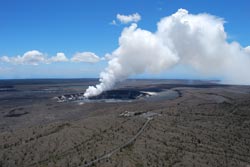UM researchers find existence of large, deep magma chamber below Kilauea volcano

<br>
A new study led by scientists at the University of Miami (UM) Rosenstiel School of Marine and Atmospheric Science uncovered a previously unknown magma chamber deep below the most active volcano in the world – Kilauea. This is the first geophysical observation that large magma chambers exist in the deeper parts of the volcano system.
Scientists analyzed the seismic waves that travel through the volcano to understand the internal structure of the volcanic system. Using the seismic data, the researchers developed a three-dimensional velocity model of a magma anomaly to determine the size, depth and composition of the lava chamber, which is several kilometers in diameter and located at a depth of 8-11 km (5 – 6.8 miles).
“It was known before that Kilauea had small, shallow magma chambers,” said Guoqing Lin, UM Rosenstiel School assistant professor of geology and geophysics and lead author of the study. “This study is the first geophysical observation that large magma chambers exist in the deep oceanic crust below.”
The study also showed that the deep chamber is composed of “magma mush,” a mixture of 10-percent magma and 90-percent rock. The crustal magma reservoir below Kilauea is similar to those widely observed beneath volcanoes located at mid-ocean ridges.
“Understanding these magma bodies are a high priority because of the hazard posed by the volcano,” said Falk Amelung, co-author and professor of geology and geophysics at the UM Rosenstiel School. “Kilauea volcano produces many small earthquakes and paying particular attention to new seismic activity near this body will help us to better understand where future lava eruptions will come from.”
Scientists are still unraveling the mysteries of the deep internal network of magma chambers and lava tubes of Kilauea, which has been in continuous eruption for more than 30 years and is currently the most active volcano in the world.
The study, titled “Seismic evidence for a crustal magma reservoir beneath the upper east rift zone of Kilauea volcano, Hawaii,” was recently published in the online edition of the journal Geology. The study co-authors include: Lin, Amelung, Yan Lavalee of the University of Liverpool and Paul G. Okubo of the U.S. Geological Survey in Hawaii. The National Science Foundation funded the study.
Image: http://gallery.usgs.gov/images/08_18_2010/h41Ogs6FEa_08_18_2010/large/HVO
_and_Halemaumau_-_horizontal.jpg
About the University of Miami's Rosenstiel School The University of Miami is one of the largest private research institution in the southeastern United States. The University's mission is to provide quality education, attract and retain outstanding students, support the faculty and their research, and build an endowment for University initiatives. Founded in the 1940's, the Rosenstiel School of Marine & Atmospheric Science has grown into one of the world's premier marine and atmospheric research institutions. Offering dynamic interdisciplinary academics, the Rosenstiel School is dedicated to helping communities to better understand the planet, participating in the establishment of environmental policies, and aiding in the improvement of society and quality of life.
Media Contact
More Information:
http://www.rsmas.miami.eduAll latest news from the category: Earth Sciences
Earth Sciences (also referred to as Geosciences), which deals with basic issues surrounding our planet, plays a vital role in the area of energy and raw materials supply.
Earth Sciences comprises subjects such as geology, geography, geological informatics, paleontology, mineralogy, petrography, crystallography, geophysics, geodesy, glaciology, cartography, photogrammetry, meteorology and seismology, early-warning systems, earthquake research and polar research.
Newest articles

Silicon Carbide Innovation Alliance to drive industrial-scale semiconductor work
Known for its ability to withstand extreme environments and high voltages, silicon carbide (SiC) is a semiconducting material made up of silicon and carbon atoms arranged into crystals that is…

New SPECT/CT technique shows impressive biomarker identification
…offers increased access for prostate cancer patients. A novel SPECT/CT acquisition method can accurately detect radiopharmaceutical biodistribution in a convenient manner for prostate cancer patients, opening the door for more…

How 3D printers can give robots a soft touch
Soft skin coverings and touch sensors have emerged as a promising feature for robots that are both safer and more intuitive for human interaction, but they are expensive and difficult…




















